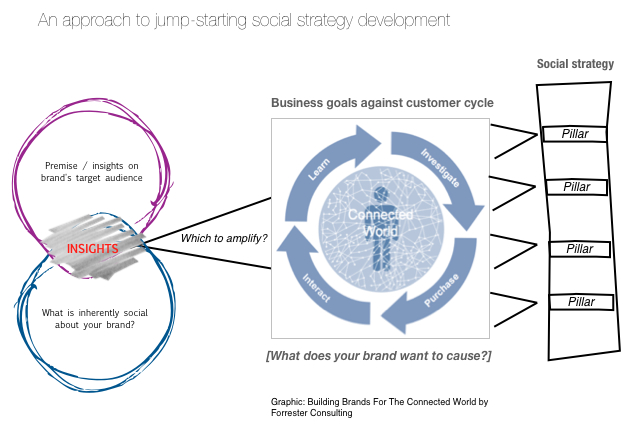Companies are starting to realise, earlier rather than later, that they need to invest in social media strategy first before spending on setting-up their Facebook page, launching a Twitter campaign, creating a Pinterest board, and oh, do something with Google+. I’ve had these kinds of conversations with clients, and eventually, they do agree.
Their concern though, is how to keep on moving forward while social strategy development is taking place. It’s quite rare to get the chance to build a social media strategy from the ground up. I’ve been in situations where research work (consumer insights, social customer persona development, competitor’ analysis) has not been taken into account in budget or project planning, because social media was just first thought of as an add-on. Only after a debrief would clients realise that the social media aspect of a campaign or project they’re running, actually requires more than what they anticipated — and that they haven’t even asked yet what their social consumers want. From a broader perspective, their company — not just the campaign they want to run — actually needs a social strategy.
For example, running a contest on Facebook that is expected go “viral” needs as a pre-requisite, a strategy. This strategy should be based on a profile of the company’s Facebook fans and an analysis of their online social behaviour and attitudes (e.g. the kind of content with which they prefer to engage, with whom do they share it with, whom they trust, what would motivate them to share, etc.). Research work needs to be done for this with the end view of developing a social customer persona. This strategic plan should also include content strategy and editorial planning to build communications around the content and create triggers for engagement. This means having dedicated resources within the organisation to address content creation and planning, and social media monitoring. All these touch on governance issues (e.g. how will the company organise for social media work, who owns social, what are the social media guidelines).
You can now see how the little social media add-on is turning into a big project by itself. And it deserves, in my opinion, to be a project by itself given all its complexities.
However, what can the client do in the meantime? How can they use social media based on a strategic framework without calling a complete halt to the other operations they’ve already started? My advice in a nutshell: Begin with the end in mind, start with a recognised need or opportunity, and grow from there. In more specific terms, you can add these activities below to your project so that you can create a starting point for strategically approaching social media requirements:
- Gather insights about your audience and your brand
- Start with the insights you have on your target audience. Gather insights and even assumptions from different teams in your company and discuss this. Highlight conflicting points and other aspects that you’d like to validate.
- Start a small survey within your network and complement this with group interviews. Combine quantitative and qualitative ways to gather the kind of information that would be relevant to the social strategy related questions you want answered, and can validate your assumptions on your target audience.
- Identify what is inherently social about your product or service. For example, does it allow people to connect and collaborate? How is it interesting for people in the social graph and more specific communities in the interest graph? Does it promote or tap into a social identity?
- Combine all these information and draw conclusions or, at the very least, develop a hypothesis about your audience and brand.
- Select which insight should be amplified to your audience in the social landscape.
- Filter these insights against the relevant business goals and specific touchpoints in the customer life cycle that would be relevant to your project. What would these insights mean, for example, to a person who is more into researching about a product compared to somebody who is already considering a purchase, or to someone who has a complaint?
- The conclusions that you would be able to draw fro this process can then be fed into determining the foundations of a social strategy, which you can apply to the project at hand.
But it shouldn’t end here. You have the beginnings of a social strategy, but this must always be reviewed and validated against the changing needs of your audience and your business. Your next steps should be to to address the most essential component of any social strategy: social customer personas. Developing your company’s social customer persona allows you to gain more correct and actionable insights on your target audience and help validate the assumptions you posited at the start. By investing on knowing damn well who your customers are, you are helping shape correctly and effectively your company’s vision for customer experiences and relationships.

Leave a Reply